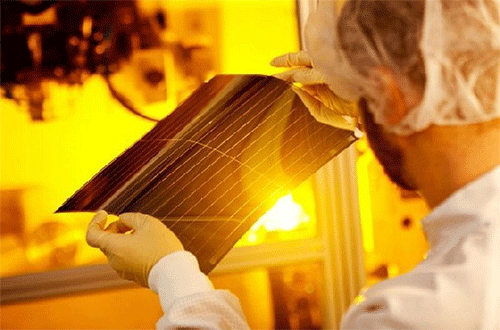Heliatek พัฒนาโซลาร์ฟิล์มโปร่งแสง ผลิตไฟฟ้าได้มากกว่า 7%
POSTED ON 16/04/2557

ข่าวเทคโนโลยี - Heliatek GmbH บริษัทชั้นนำของโลกด้านการผลิตฟิล์มเซลล์แสงอาทิตย์ชนิดสารอินทรีย์ (Organic solar film) สร้างสถิติใหม่ในการปรับปรุงประสิทธิภาพของเซลล์แสงอาทิตย์แบบโปร่งแสง โดยล่าสุด บริษัทฯ ได้พัฒนาเซลล์แสงอาทิตย์ชนิดอินทรีย์ที่มีค่าความโปร่งแสงสูงสุด 40% ให้มีประสิทธิภาพในการผลิตพลังงานไฟฟ้ามากกว่า 7% ทั้งนี้ ปัจจุบันบริษัทฯ ยังเป็นเจ้าของสถิติโลกสำหรับเซลล์แสงอาทิตย์ชนิดอินทรีย์แบบทึบแสง ด้วยประสิทธิภาพการผลิตพลังงานสูงถึง 12%
การพัฒนาในห้องปฏิบัติการครั้งล่าสุดนี้เน้นย้ำถึงกลยุทธ์ของบริษัทในการผลิตฟิล์ม HeliaFilm แบบโปร่งแสงเพื่อป้อนให้กับผู้ผลิตกระจกทั้งสำหรับเป็นส่วนประกอบของอาคาร (BIPV) และสำหรับหลังคารถยนต์ "ความโปร่งแสงของผลิตภัณฑ์ถือเป็นหัวใจสำคัญในวิธีเปรียบเทียบราคาตลาดของเรา ฟิล์ม HeliaFilm ถูกผลิตขึ้นตามความต้องการที่เฉพาะเจาะจงของคู่ค้า” Thibaud Le Seguillon ซีอีโอของ Heliatek กล่าว “เราเป็นผู้จัดหาชิ้นส่วนประกอบ และชิ้นส่วนประกอบนี้ก็คือฟิล์มซึ่งรวมคุณสมบัติด้านความโปร่งแสงและการผลิตพลังงานเข้าไว้ด้วยกัน การผสมผสานที่เป็นเอกลักษณ์เฉพาะตัวนี้ช่วยให้เราสามารถขยายศักยภาพด้านตลาดได้กว้างขึ้น"
ในการใช้งานทั้งสำหรับอาคารและหลังคารถยนต์นั้น ต้องใช้กระจกสีเพื่อลดแสงจ้า ซึ่งสามารถทำได้ด้วยการติดฟิล์ม ดังนั้นการเปลี่ยนจากฟิล์มธรรมดามาเป็นฟิล์มที่สามารถผลิตไฟฟ้าได้ด้วยนั้นจึงถือเป็นการเพิ่มคุณสมบัติสำหรับผู้ผลิต การใช้ HeliaFilm บนกระจกหลังคารถไม่เพียงแต่ช่วยผลิตพลังงานเท่านั้น แต่ยังจะช่วยให้บริษัทผู้ผลิตรถยนต์เป็นที่ยอมรับในเรื่องนวัตกรรมสิ่งแวดล้อมที่มีเป้าหมายเพื่อลดการปล่อยก๊าซคาร์บอนไดออกไซด์อีกด้วย หน้าต่างและแผ่นกระจกในงานสถาปัตยกรรมที่ติดฟิล์ม HeliaFilm ช่วยให้สามารถผลิตไฟฟ้าได้จากผนังด้านนอกของอาคาร
ฟิล์มเซลล์แสงอาทิตย์ชนิดอินทรีย์รุ่นใหม่ล่าสุดที่มีความโปร่งแสง 40% นั้น ได้รับการปรับปรุงประสิทธิภาพการผลิตพลังงานไฟฟ้าเพิ่มสูงสุดเป็น 7.2% การวัดค่าดังกล่าวเป็นไปตามมาตรฐานการทดสอบสภาพการใช้งานโดยใช้พื้นหลังสีขาว ซึ่ง Heliatek ประสบความสำเร็จในการแปลงพลังงานได้สูงสุดด้วยฟิล์ม HeliaFilm แบบโปร่งแสง ปัจจุบันฟิล์มแบบทึบแสงของบริษัทมีประสิทธิภาพเซลล์แสงอาทิตย์ 12% ซึ่งเทียบเท่ากับประสิทธิภาพเซลล์แสงอาทิตย์แบบโปร่งแสงที่ 7.2% เนื่องจากการโปร่งแสงบางส่วนทำให้สามารถเก็บเกี่ยวพลังงานจากแสงอาทิตย์มาใช้ได้เพียง 60% ความสมดุลระหว่างแสงที่ผ่านเข้ามาและการผลิตไฟฟ้านั้นสามารถปรับได้ ซึ่งจะขึ้นอยู่กับการใช้งาน การผลิตฟิล์ม HeliaFilm แบบโปร่งแสงเป็นไปได้ด้วยการใช้ชั้นฟิล์มที่เป็นสื่อทั้งด้านหน้าและด้านหลังของเซลล์แสงอาทิตย์
การผลิตฟิล์ม HeliaFilm เกิดจากโมเลกุลขนาดเล็ก (Oligomers) ซึ่งตกผลึกที่อุณหภูมิต่ำในกระบวนการสูญญากาศแบบ roll-to-roll สเปกตรัมการดูดกลืนแสงนั้นมีเป้าหมายอยู่ที่สีที่แตกต่างกัน และความโปร่งแสงในการแปลงแสงอาทิตย์ให้เป็นไฟฟ้า

Heliatek GmbH, world-leading company in the production of organic solar film, has reached a new record in the efficiency of transparent solar cells. The latest development allows transparency levels up to 40% with an efficiency of over 7%. The company already holds the world record of 12% cell efficiency for opaque (non-transparent) organic solar cells.
This lab development underscores the company's strategy to supply its transparent HeliaFilm to glass manufacturers for both building integration (BIPV) and car roofs. "The transparency of our products is at the core of our market approach. Our HeliaFilm is customized to meet our partners' specific needs," added Thibaud Le Seguillon, Heliatek CEO. "We are a component supplier and this component is a film which can combine transparency and energy generation. This unique combination widens our market potential."
Both these application areas use tinted glass to reduce glare which can be done by applying a film, so changing the film to one that generates electricity as well is a drop-in for manufacturers. Using HeliaFilm in glass car roofs will not only generate energy, but will also allow the car manufacturers to claim Eco-innovation credits towards CO2 emission goals. Architectural glass panels and windows incorporating HeliaFilm enable electricity to be discretely generated on the outside envelope of a building.
The latest generation of organic solar cells with a 40% light transparency reaches an efficiency record of 7.2%. The measurement follows standard testing conditions using a white background. Heliatek thus succeeded in generating an optimal energy conversion for transparent HeliaFilm. Currently, its opaque cells achieve 12% efficiency. 7.2% cells mirror the same efficiency, since the partial transparency allows the usage of only 60% of the light for the energy harvesting. Depending on the application, the balance between light let through and electricity generated can be adjusted. The production of transparent HeliaFilm is possible with the introduction of transparent conductive layers at the front- and back-side of the solar cells.
The production of HeliaFilm is based on small molecules (oligomers). Oligomers are deposited at low temperatures in a roll-to-roll vacuum process. Their selective absorption of the solar spectrum targets different colors and transparency to convert sunlight into electricity.

